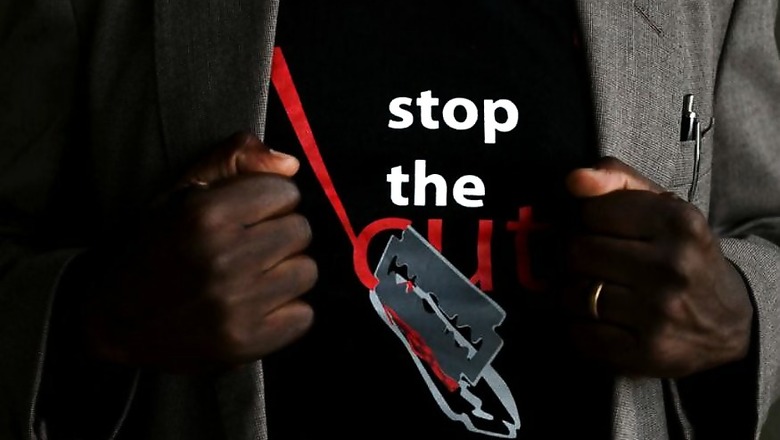
views
New Delhi: The practice of female genital mutilation among Dawoodi Bohras has been a long-standing debate, while a recent report by a non-profit group has established that India is a hub of the practice with no laws to put it in check.
It is one of the first studies to document the impact that female genital mutilation has on the victims.
According to the World Health Organization (WHO), FGM comprises "all procedures that involve the altering or injuring of female genitalia for non-medical purposes and is recognised internationally as a violation of the human rights of girls and women".
A majority of Bohras practice Type 1 FGM/C (partial or total removal of the clitoris and/or clitoral hood/prepuce). Though supporters of ‘khafd’ or female genital mutilation (FGM) in India claim Bohras practice the ‘removal of clitoral hood’ (Type 1a) and ‘pricking, piercing, cauterization’ (Type 4 FGM/C); participants in the study, including a doctor (OBGYN) observed that while both practices are prevalent among the Bohras, there are a very few cases of ‘pricking, piercing, cauterization’.
The survey on the prevalence of FGM or "khafd" among the Bohras in the country also highlighted that in the urban areas increasingly doctors in medical facilities also performed F`GM in addition to traditional cutters.
One of the key findings of the report titled "The Clitoral Hood a Contested Site: Khafd or Female Genital Mutilation in India" was that “India was viewed as a hub for the performance of female genital mutilation (FGM) on Bohra expat/foreign girls. This was primarily due to the recent legal action on FGM/C among Bohras in Australia and USA, and the lack of an anti-FGM/C law in India.”
While India has no law recognizing female genital cutting or mutilation, other countries do. In 2016, Australia sentenced three Dawoodi Bohras to 15 months in jail under the country’s female genital mutilation law. In 2017, United States officials arrested two doctors in Detroit for allegedly cutting the private parts of at least six girls. The trial is still underway.
In India, advocate Sunita Tiwari began the fight in 2017 when she filed a PIL seeking a ban on the practice. In December, the Ministry of Women and Child Development informed the apex court that there was no official data from the National Crime Records Bureau (NCRB) or other sources acknowledging the existence of FGM in India.
However, the new study released by the social activists reveals that 75% of the daughters (aged seven years and above) of all respondents in the sample group were subjected to FGM/C. These young girls are usually subjected to ‘khafd’ when they are about seven years old.
The report was prepared by social activists Lakshmi Anantnarayan, Shabana Diler and Natasha Menon, along with WeSpeakOut and Nari Samata Manch. The study had 94 participants, of which 83 were women and 11 men.
The report, which includes personal stories of survivors, has revealed that FGM was a painful experience that left a physical scar on them even after years.
“Khafd was remembered as a painful experience by 97% of the women who took part in the study. Women reported painful urination, physical discomfort, difficulty in walking, and bleeding immediately following the procedure. Some women suffered from recurrent Urinary Tract Infections (UTIs) and incontinence in the long-term,” the report notes.
The respondent women hailed from thirteen locations across five states: Gujarat, Madhya Pradesh, Maharashtra, Rajasthan and Kerala. Additionally, Bohra expats from three countries (Canada, United Arab Emirates, and the United States of America) also took part in the study. The sample group also includes traditional circumcisers, healthcare professionals, and teachers.
The report further highlights how the removal of the clitoris in women resulted in them lacking any sexual drive or activity.
Approximately 33% of the women subjected to ‘khafd’ in the study believe FGM/C has negatively impacted their sexual life.
“Low sex drive, inability to feel any sexual pleasure, difficulty in trusting sexual partners, and over sensitivity in the clitoral area were some of the problems identified by several women,” say the researchers.
There is approximately one million Dawoodi Bohras globally and the study says about 88 women victims have identified 1,248 others in their immediate family circles to have undergone the practice.
Moreover, while the practice is known to have been confined only to women, it also has men playing a key role in it.
“Bohra men do participate in ‘khafd’ (actively and passively) and have an integral role in its maintenance and/or propagation, both at personal and political levels,” notes the report.
The report further states that the words used by women to describe what they felt during the procedure were mostly, ‘nose prick’, ‘pinch’, ‘injection’, ‘prick of a needle’, ‘nick’, ‘strongly pinched’, ‘ant bite’, ‘injection’ or ‘piercing pain’.
Materials used after ‘khafd’ is performed, as recalled by the women, are talcum powder, ash, turmeric, Dettol, white antiseptic powder, Soframycin, boric powder, ether/spirit, Tincher Benzoine, painkillers, black ointment, red ointment, cotton or diaper cloth.




















Comments
0 comment